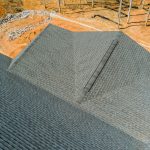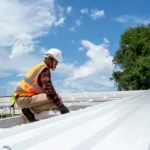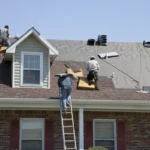PVC roofing is a proven solution for flat and low-slope buildings that demand durability, waterproofing, and energy savings. It’s a favorite in commercial settings and increasingly popular in residential construction. This guide explains everything from what PVC roofing is, to its installation process, cost per square foot, lifespan, and how it compares to TPO and EPDM roofing systems.

Content
What Is PVC Roofing?
PVC roofing, short for polyvinyl chloride roofing, is a type of single-ply membrane designed primarily for flat or low-slope roofs. It’s made from two layers of PVC material reinforced with polyester or fiberglass. These layers are heat-welded, creating a strong, watertight bond that resists moisture, chemicals, and environmental wear.
This roofing type is especially valued for its durability, chemical resistance, and ease of installation.
PVC Roof Systems Explained
A typical PVC roofing system is installed in rolls or sheets and attached to the roof deck using mechanical fasteners or adhesive. One of its greatest strengths is the ability to heat-weld seams, creating a continuous waterproof membrane.
These systems often include an insulation layer for energy efficiency. The overall result is a resilient, low-maintenance, and highly reflective surface ideal for commercial applications.
White PVC Roof Benefits
One of the standout features of PVC roof is its color. White PVC roof benefits include reflecting sunlight, which significantly lowers indoor temperatures. This leads to reduced air conditioning usage and noticeable energy savings.

Reflective PVC membranes also qualify for green certifications and help reduce the urban heat island effect. For those focused on sustainability, PVC is a compelling, eco-friendly option.
PVC Roofing Pros and Cons
Like any roofing material, PVC roof has its advantages and limitations. Here’s a breakdown to help you assess its suitability.
Pros:
- Long-lasting, with a lifespan of 20–30 years
- Energy-efficient due to high solar reflectivity
- Resistant to chemicals, grease, and fire
- Low maintenance requirements
- Excellent for flat commercial roofs
Cons:
- Higher initial cost than TPO or EPDM
- May become brittle in freezing temperatures
- Requires skilled, professional installation
PVC Roofing Cost per Square Foot
Cost is a crucial factor for any roofing project. The pvc roof cost per square foot typically ranges from $6 to $12, depending on factors like:

- Roof size and shape
- Membrane thickness
- Labor costs in your region
- Type of insulation used
While the initial expense is higher than TPO, PVC offers better long-term durability and savings, especially in energy costs.
PVC Roofing Installation Process
The pvc roof installation process involves several steps to ensure durability and performance. First, the roof is cleaned and prepped. Insulation is installed if needed. Next, PVC sheets are rolled out and heat-welded at the seams.
Special attention is paid to flashing around vents and edges. Once complete, the result is a strong, seamless membrane that resists water, chemicals, and fire.
PVC Roof Lifespan: How Long Does It Last?
One of the biggest advantages of PVC is its long lifespan. When installed and maintained properly, PVC roof can last 20 to 30 years or more. Factors that influence longevity include:
- Quality of the membrane
- Thickness (45 mil to 80 mil options)
- Exposure to harsh environments
- Frequency of inspections and upkeep
Proper care will ensure decades of reliable performance.
PVC Roofing vs TPO vs EPDM: What’s the Difference?
If you’re comparing PVC roof vs TPO and PVC roof vs EPDM, it’s important to understand how each performs.
PVC vs TPO:
- PVC is more durable and better with chemicals
- TPO is typically cheaper
- Both use heat-welded seams
- PVC often offers a longer service life
PVC vs EPDM:
- EPDM is rubber-based and more flexible
- PVC is better at reflecting sunlight
- EPDM uses taped seams, less reliable than welding
- PVC handles grease, fire, and UV exposure more effectively
Best PVC Roof Brands
Quality matters when selecting roofing materials. Some of the best PVC roof brands include:
- Duro-Last
- GAF EverGuard
- Versico
- Sika Sarnafil
- Carlisle SynTec Systems
These brands are known for long warranties, proven performance, and a wide selection of membrane thicknesses and features.
Energy Efficiency and Environmental Benefits
One of the major perks of PVC roof is its energy efficiency. Thanks to its reflective surface, PVC helps keep buildings cooler in the summer by reflecting solar radiation.
In addition to reducing energy bills, PVC membranes are recyclable, making them a smart choice for eco-conscious property owners. They also contribute toward LEED certification points for sustainable building.
Conclusion
PVC roofing stands out as a top-tier choice for flat and low-slope roofs due to its durability, low maintenance, and energy efficiency. With a lifespan that rivals or exceeds most alternatives, PVC membrane roofing systems deliver excellent value over time. Whether you’re managing a commercial property or upgrading your home’s roof, PVC roof offers a reliable, eco-conscious, and cost-effective solution.
Your home’s air quality depends largely on what’s hidden inside your ductwork, but the protection above your head matters too. PVC roofing offers a durable, weather-resistant solution that keeps your home safe from leaks, UV damage, and harsh weather conditions. Understanding its benefits can help you make smarter home improvement decisions. If you want to promote your roofing services or products, you can advertise with us to reach homeowners looking for reliable roofing solutions.
Frequently Asked Questions (FAQs)
Is PVC Roofing Worth the Investment?
Yes, especially for commercial or flat roofs. Though more expensive initially, PVC roof offers long-term savings, fewer repairs, and energy efficiency—making it a smart investment.
Can PVC Roof Be Installed Over Existing Roofs?
In some cases, yes. A new PVC roof can be installed over an existing flat roof if the current structure is sound and meets local code requirements. A professional inspection is always recommended.
How Do I Maintain PVC Roofing?
PVC roof maintenance is minimal. Annual inspections, basic cleaning with mild soap, and keeping drains clear are usually enough. Prompt repairs of punctures or seam issues will extend its life.

My name is Author Name. I post about home improvement ideas and how to make your home look beautiful and liveable. I hope my posts will help you with your DIY projects!












